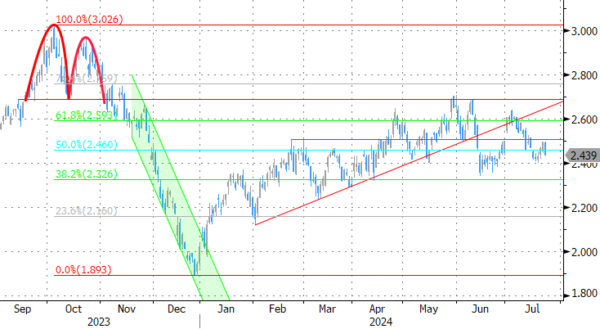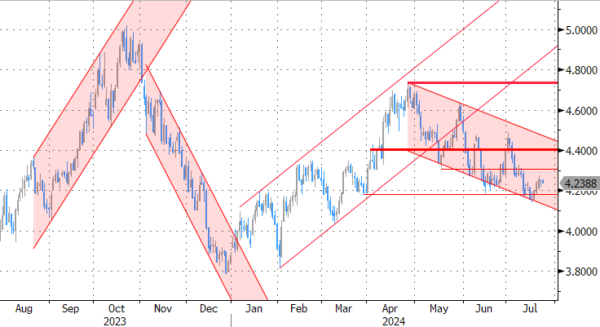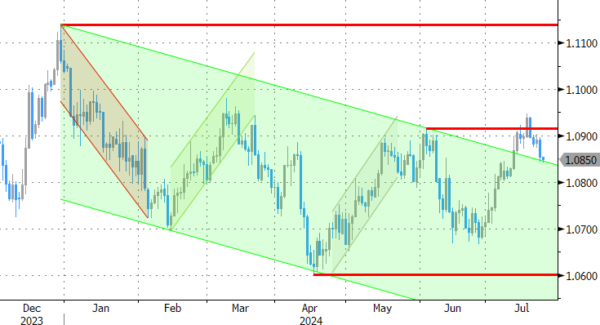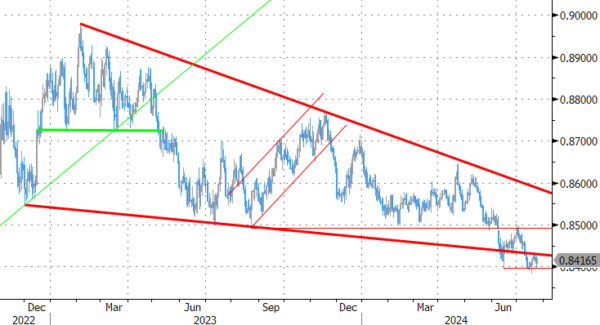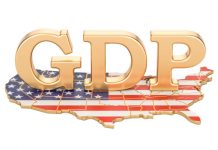Markets
In a session with few important data core bonds remained well bid, Bunds outperforming Treasuries. German yields declined between -11.6 bps (2-y, benchmark change) and -4.5 bps (30-y) in a bull steepening move. Investors apparently stay confident that the ECB will able to continue its easing cycle as of September even as June EMU inflation data showed disinflation, especially core inflation, proceeds only very gradually (if any). ECB’s de Guindos indicated that inflation might hover at current levels for the remainder of this year, but he sees all measures of underlying inflation coming down which should result in disinflation continuing next year. He also saw signs of moderation in wage increases. He evidently didn’t commit on a rate cut timing, but indicated that new projections available at the September meeting will provide a good opportunity to reassess the monetary policy stance. The US yield curve also steepened slightly with the 2-year declining 2.6 bps and the 30-y gaining 1.2 bps. A $69 bln US 2-y Note auction attracted solid investor buying interest (bid-cover 2.81). US equities struggled to find a clear direction (S&P 500 -0.16%) looking forward to earnings of Alphabet and Tesla. Earnings disappointed markets with futures declining after the close. The dollar extended its comeback against the likes of the euro (EUR/USD close 1.0854 from 1.089) or the Aussie dollar (currently 0.66 area). The yen still outperformed the greenback (close 155.6).
Sentiment in Asia this morning turned further risk-off in the wake of yesterday’s WS tech earnings. US yields decline (marginally). The yen extends its comeback (USD/JPY 154.75) supported by a strong Japan Jibun Services PMI (53.9 from 49.4). Later today, investors will also look out for the July PMI’s in the US, EMU and the UK. Last month, US PMI’s painted a more favourable picture compared to the ISM’s. For July, the US composite PMI is expected at a still strong 54.2 (from 54.8). In current market momentum, we see (interest) markets giving more weight to a downward surprise rather than to a strong figure. The EMU composite PMI is expected unchanged at 50.9. After the ‘France-driven’ decline last month, maybe there is room for a small rebound. We don’t expect that to change markets’ expectations the ECB rate path but if so, it might slow the recent EUR/USD setback. A better UK PMI post the elections (if so, composite expected 52.6) also might trigger a new EUR/GBP test of the 0.84 barrier.
News & Views
Fitch kept Canada’s rating unchanged at AA+ with a stable outlook yesterday. The rating agency hailed the strong governance, high per-capita income and a macroeconomic policy framework that has delivered steady growth and generally low inflation. A high, albeit falling, public debt burden counterbalances these strong credit fundamentals somewhat. The agency expects deficits to rise to 1.5% of GDP this year. While seen narrowing to 1.4% and 1% and the years after, they are still materially higher than the pre-pandemic levels . After peaking at 108.7% in 2020, Fitch forecasts the debt ratio at 84.5% this year and 83.4% in 2026. While significantly above the AA median of 49.4%, it is “somewhat mitigated by substantial assets, including national pension assets equal to 27% of GDP in 2024.” Growth should improve from 1% last year towards 1.5% in 2025 and 2026. Fitch singled out a downturn in the US or new tariff (increases) as downside risks. In terms of monetary policy, Fitch believes the central bank will cut another three times this year to 4% with a terminal rate of 2.5% end 2026. The Bank of Canada has the occasion to do so later today. A 25 bps rate cut to 4.5% is almost fully priced in by markets.
The Hungarian central bank (MNB) cut the policy rate by 25 bps yesterday to 6.75%. The unanimous decision was no major surprise in the wake of softer-than-expected June inflation numbers and deputy governor Virag comments afterwards. CPI came in at 3.7%, within the MNB’s tolerance band (3% +/- 1 ppt) where it is expected to stay in the next several months. Core inflation (4.1%), however, will rise towards 5% by year’s end, warranting a cautious and data-driven approach to monetary policy. Volatility in international investor sentiment, i.e. HUF stability, is an additional important reason. The forint in the run-up to the meeting already gave its blessing for a cut strengthening below EUR/HUF 390 for the first time since early June. The currency did lose some marginal ground in the wake of the decision though (EUR/HUF close at 390.26). Virag in the presser said market bets for one to two more rate cuts this year is realistic.
Graphs
GE 10y yield
The ECB cut its key policy rates by 25 bps at the June policy meeting. A more bumpy inflation path in H2 2024, the EMU economy gradually regaining traction and the Fed’s higher for longer US strategy make follow-up moves difficult. Markets are coming to terms with that. Meanwhile, much of the save haven bids were reversed after the (first round in) the French elections. The 2.34%-2.4% support zone looks solid.
US 10y yield
The Fed indicated that it needs more evidence to lower its policy rate. June dots suggested one move in 2024 and four next year. Disappointing ISM and back-to-back downward CPI surprises put the US money market back on (at least) two rate cuts this year (September/December). The US 10-yr yield tests the recent lows and the downside of the downward trend channel in the 4.2% area.
EUR/USD
EUR/USD is testing the topside of the 1.06-1.09 range as the dollar loses interest rate support at stealth pace. Markets consider a September rate cut a done deal and only need confirmation from high-ranked Fed officials. In the meantime, the euro got rid of the (French) political risk premium. Risks of a topside break have increased, bringing the psychologic 1.10 and the December 2023 top at 1.1139 on the radar.
EUR/GBP
Debate at the BOE is focused at the timing of rate cuts. May headline inflation returned to 2%, but core measures weren’t in line with inflation sustainably returning to target any time soon. Still some BoE members at the June meeting appeared moving closer to a rate cut. Labour has yet to reveal its policy plans after securing a landslide election victory. EUR/GBP 0.84 support is being tested.




